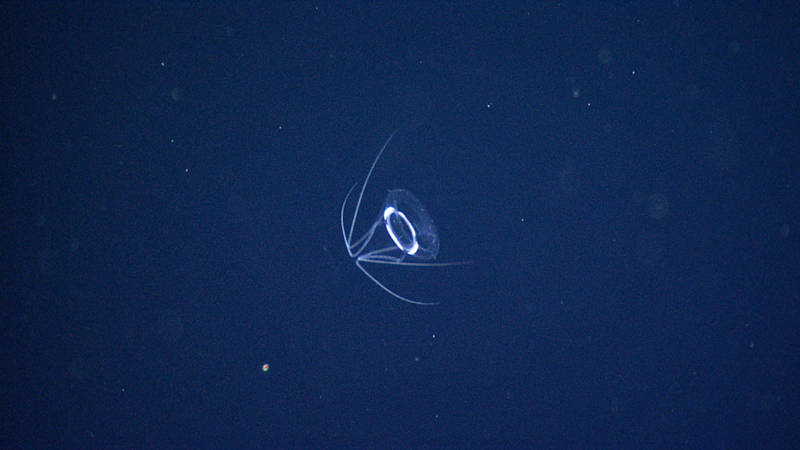
An unidentified jellyfish (possibly Narcomedusae?) with bent tentacles was sighted during the pelagic transects. Image courtesy of NOAA Okeanos Explorer Program, Gulf of Mexico 2014 Expedition. Download larger version (jpg, 1.8 MB).

An unidentified jellyfish (possibly Narcomedusae?) with bent tentacles was sighted during the pelagic transects. Image courtesy of NOAA Okeanos Explorer Program, Gulf of Mexico 2014 Expedition. Download larger version (jpg, 1.8 MB).
Dive 10 started with five 15-minute mid-water transects occurring in 100-meter intervals between 800 and 1,200 meters to examine pelagic fauna. Sighted during the transects were: shrimp, salps, ctenophores, bristle mouth fish, siphonophores, chaetognaths, “sinkers” (remnant mucus feeding sacks from larvaceans), hatchet fish, a sea butterfly (i.e. Pteropods- the animals who’s shells are seen on the sediment during most of the dives), and a few different types of jellyfish.
The second portion of the dive conducted a transect up the western wall of Bryant Canyon, starting from a depth of 2,813 meters on sediment-covered seafloor. Biota in the area included a few sea cucumbers, glass sponges, fish, sea stars, shrimp, anemones, sea pens, and a few snail fish. The first extensive hardground outcrops began at a depth of 2,765 meters. Furrows, similar to those found on Dive 9 on the other side of Bryant Canyon, were observed at 2,584 meters. In this area, Deep Discoverer (D2) encountered human debris, anemones, glass sponges, tunicates, cusk eels, tripod fish, and squat lobsters. More extensive hardgrounds were observed beginning at a depth of 2,531 meters. Sea stars, glass sponges, and sea cucumbers were common throughout the rest of the dive and flytrap anemones were common on steep slopes. Hardgrounds and layered outcrops persisted, with occasional near-vertical slopes, until the top of the slope, near the end of the dive. Although mostly barren, D2 documented one crinoid, a few glass sponges, sea stars, squat lobsters, polychaetes, sea pens, shrimp, and tripod fish. Rippled seafloor also occurred intermittently near the top of the slope. The dive ended at a depth of 2,470 meters.